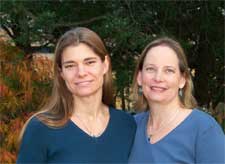 KINGSTON, R.I. – December 12, 2008 — The University of Rhode Island’s Watershed Watch program has been touted as one of the best volunteer water quality monitoring programs in the country, and now the two people who have been largely credited for its success are taking their expertise on the road to help similar programs become more effective.
KINGSTON, R.I. – December 12, 2008 — The University of Rhode Island’s Watershed Watch program has been touted as one of the best volunteer water quality monitoring programs in the country, and now the two people who have been largely credited for its success are taking their expertise on the road to help similar programs become more effective.
Linda Green, program director, and Elizabeth Herron, program coordinator, residents of West Kingston and Exeter respectively, recently landed a $380,000 grant from the U.S. Department of Agriculture’s National Integrated Water Quality Program. Together with the University of Wisconsin in Madison and Salish Kootenai College, a tribal college in Pablo, Montana, they will be seeking out other volunteer monitoring groups and guiding them to methods that will facilitate the dissemination of data to people, communities and agencies.
“We want to find out what groups there are, what they are doing and what are their needs in order to best use the information they are generating,” said Green.
There are about 50 volunteer monitoring groups in the country that are linked with university Cooperative Extension programs such as at URI, explained Herron, but it is estimated there are 1,000 other groups that also monitor water quality—some run by state agencies, some by community and watershed groups, and some run by Sea Grant.
The new grant builds on past efforts by offering help to monitoring groups whose data collection can be as diverse as the bodies of water they are monitoring.
While all volunteer monitoring groups look for some common data, there is a tremendous range of variables because different issues are involved. While one group may be monitoring a lake to make sure it is safe for swimming, another may be monitoring an estuary out of concern for wildlife, and another because there may be concerns about the potability of a stream entering a drinking water reservoir.
“There is a tremendous need to monitor our water resources, not only to restore the polluted ones but also to protect the pristine ones,” said Herron. The new grant will enable Herron, Green and others to provide more topical advice such as how to get a monitoring program started, manage data, check bacteria levels or present the data to various audiences.
The idea for the new grant grew out of previous grant projects and from annual USDA national water conferences that the two women attended. Indian tribes sent representatives to these conferences, discussions focused on the unique needs of tribal communities, and the idea for a three-way partnership resulted.
The biggest challenge to be tackled with the grant will be to provide groups with the ability to make their accumulated data available to the public easily and quickly.
“Some groups have their data online, others may have it in a box under a desk,” said Green. “We are concerned that there be no barriers to the data and that it is accessible in useful and usable ways.”
By making the data readily available and understandable, individuals, groups, developers and public bodies will be able to work faster when a project arises that could affect a body of water. In some cases, the current processes are cumbersome and time-consuming. Getting data in some places can take years, said Herron, especially in areas where state agencies are understaffed.
Not so in Rhode island.
The URI Watershed Watch program had 400 volunteers in 2008 monitoring 250 sites throughout Rhode Island and eastern Connecticut, and they submit reports throughout the warm weather months. Each spring a new training class is held to replenish the ranks of the volunteers.
“People ask us what do we do in the winter,” said Herron. “We spend the winter entering data and getting ready for the spring. We have plenty of work.”
For information about URI Watershed Watch, visit www.uri.edu/ce/wq/ww, and to learn about national water quality monitoring efforts, visit www.usawaterquality.org/volunteer.
Pictured above
Elizabeth Herron (left) and Linda Green.

